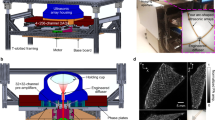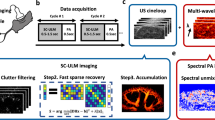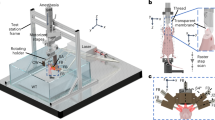Abstract
Positron emission tomography–computed tomography (PET–CT) is the most sensitive molecular imaging modality, but it does not easily allow for rapid temporal acquisition. Ultrafast ultrasound imaging (UUI)—a recently introduced technology based on ultrasonic holography—leverages frame rates of up to several thousand images per second to quantitatively map, at high resolution, haemodynamic, biomechanical, electrophysiological and structural parameters. Here, we describe a pre-clinical scanner that registers PET–CT and UUI volumes acquired simultaneously and offers multiple combinations for imaging. We demonstrate that PET–CT–UUI allows for simultaneous images of the vasculature and metabolism during tumour growth in mice and rats, as well as for synchronized multi-modal cardiac cine-loops. Combined anatomical, functional and molecular imaging with PET–CT–UUI represents a high-performance and clinically translatable technology for biomedical research.
This is a preview of subscription content, access via your institution
Access options
Access Nature and 54 other Nature Portfolio journals
Get Nature+, our best-value online-access subscription
$29.99 / 30 days
cancel any time
Subscribe to this journal
Receive 12 digital issues and online access to articles
$99.00 per year
only $8.25 per issue
Buy this article
- Purchase on Springer Link
- Instant access to full article PDF
Prices may be subject to local taxes which are calculated during checkout




Similar content being viewed by others
References
Weissleder, R. & Pittet, M. J. Imaging in the era of molecular oncology. Nature 452, 580–589 (2008).
Hanahan, D. & Weinberg, R. A. Hallmarks of cancer: the next generation. Cell 144, 646–674 (2011).
Beyer, T. et al. A combined PET/CT scanner for clinical oncology. J. Nucl. Med. 41, 1369–1379 (2000).
Hasegawa, B. H. et al. Dual-modality imaging of cancer with SPECT/CT. Technol. Cancer Res. Treat. 1, 449–458 (2002).
Schmand, M. et al. BrainPET: first human tomograph for simultaneous (functional) PET and MR imaging. J. Nucl. Med. 48, 45P (2007).
Judenhofer, M. S. et al. Simultaneous PET–MRI: a new approach for functional and morphological imaging. Nat. Med. 14, 459–465 (2008).
Mace, E. et al. Functional ultrasound imaging of the brain. Nat. Methods 8, 662–664 (2011).
Errico, C. et al. Ultrafast ultrasound localization microscopy for deep super-resolution vascular imaging. Nature 527, 499–502 (2015).
Sieu, L.-A. et al. EEG and functional ultrasound imaging in mobile rats. Nat. Methods 12, 831–834 (2015).
Osmanski, B.-F., Pezet, S., Ricobaraza, A., Lenkei, Z. & Tanter, M. Functional ultrasound imaging of intrinsic connectivity in the living rat brain with high spatiotemporal resolution. Nat. Commun. 5, 5023 (2014).
Herholz, K. & Ebmeier, K. Clinical amyloid imaging in Alzheimer’s disease. Lancet Neurol. 10, 667–670 (2011).
Han, S. et al. Subregional pattern of striatal dopamine transporter loss on 18F FP-CIT positron emission tomography in patients with pure akinesia with gait freezing. JAMA Neurol. 73, 1477–1484 (2016).
Irkle, A. et al. Identifying active vascular microcalcification by (18)F-sodium fluoride positron emission tomography. Nat. Commun. 6, 7495 (2015).
Molecular Imaging and Contrast Agent Database (MICAD) (National Center for Biotechnology Information, Bethesda, MD, 2004); https://www.ncbi.nlm.nih.gov/books/NBK5330/
Tanter, M. & Fink, M. Ultrafast imaging in biomedical ultrasound. IEEE Trans. Ultrason. Ferroelectr. Freq. Control. 61, 102–119 (2014).
Tanter, M. et al. Quantitative assessment of breast lesion viscoelasticity: initial clinical results using supersonic shear imaging. Ultrasound Med. Biol. 34, 1373–1386 (2008).
Provost, J., Lee, W.-N., Fujikura, K. & Konofagou, E. E. Imaging the electromechanical activity of the heart in vivo. Proc. Natl. Acad. Sci. USA 108, 8565–8570 (2011).
Imbault, M. et al. Robust sound speed estimation for ultrasound-based hepatic steatosis assessment. Phys. Med. Biol. 62, 3582–3598 (2017).
Fernández-Sánchez, M. E. et al. Mechanical induction of the tumorigenic β-catenin pathway by tumour growth pressure. Nature 523, 92–95 (2015).
Demené, C. et al. 4D microvascular imaging based on ultrafast Doppler tomography. NeuroImage 127, 472–483 (2016).
Provost, J. et al. 3D ultrafast ultrasound imaging in vivo. Phys. Med. Biol. 59, L1–L13 (2014).
Timmers, H. J. L. M. et al. Superiority of fluorodeoxyglucose positron emission tomography to other functional imaging techniques in the evaluation of metastatic SDHB-associated pheochromocytoma and paraganglioma. J. Clin. Oncol. 25, 2262–2269 (2007).
Favier, J. et al. The Warburg effect is genetically determined in inherited pheochromocytomas. PLoS ONE 4, e7094 (2009).
Letouzé, E. et al. SDH mutations establish a hypermethylator phenotype in paraganglioma. Cancer Cell. 23, 739–752 (2013).
Lussey-Lepoutre, C. et al. In vivo detection of succinate by magnetic resonance spectroscopy as a hallmark of SDHx mutations in paraganglioma. Clin. Cancer Res. 22, 1120–1129 (2016).
Pouysségur, J., Franchi, A. & Pagès, G. pHi, aerobic glycolysis and vascular endothelial growth factor in tumour growth. Novartis Found. Symp. 240, 186–196 (2001).
Pouysségur, J., Franchi, A., Salomon, J. C. & Silvestre, P. Isolation of a Chinese hamster fibroblast mutant defective in hexose transport and aerobic glycolysis: its use to dissect the malignant phenotype. Proc. Natl. Acad. Sci. USA 77, 2698–2701 (1980).
Franchi, A., Silvestre, P. & Pouysségur, J. A genetic approach to the role of energy metabolism in the growth of tumor cells: tumorigenicity of fibroblast mutants deficient either in glycolysis or in respiration. Int. J. Cancer 27, 819–827 (1981).
Osmanski, B.-F. et al. Ultrafast Doppler imaging of blood flow dynamics in the myocardium. IEEE Trans. Med. Imaging 31, 1661–1668 (2012).
Pernot, M. et al. Shear wave imaging of passive diastolic myocardial stiffness: stunned versus infarcted myocardium. JACC Cardiovasc. Imaging 9, 1023–1030 (2016).
Pernot, M. et al. Real-time assessment of myocardial contractility using shear wave imaging. J. Am. Coll. Cardiol. 58, 65–72 (2011).
Porter, T. R. & Xie, F. Myocardial perfusion imaging with contrast ultrasound.JACC Cardiovasc. Imaging 3, 176–187 (2010).
Papadacci, C., Tanter, M., Pernot, M. & Fink, M. Ultrasound backscatter tensor imaging (BTI): analysis of the spatial coherence of ultrasonic speckle in anisotropic soft tissues. IEEE Trans. Ultrason. Ferroelectr. Freq. Control. 61, 986–996 (2014).
Maresca, D. et al. Noninvasive imaging of the coronary vasculature using ultrafast ultrasound. JACC Cardiovasc. Imaging https://doi.org/10.1016/j.jcmg.2017.05.021 (2017).
Piert, M. et al. 18F-choline PET/MRI: the additional value of PET for MRI-guided transrectal prostate biopsies. J. Nucl. Med. 57, 1065–1070 (2016).
Porporato, P. E., Dhup, S., Dadhich, R. K., Copetti, T. & Sonveaux, P. Anticancer targets in the glycolytic metabolism of tumors: a comprehensive review. Front. Pharmacol. 2, 49 (2011).
Sonveaux, P. et al. Targeting lactate-fueled respiration selectively kills hypoxic tumor cells in mice. J. Clin. Invest. 118, 3930–3942 (2008).
Konofagou, E. E., D’hooge, J. & Ophir, J. Myocardial elastography—a feasibility study in vivo. Ultrasound Med. Biol. 28, 475–482 (2002).
Martín, A. et al. Imaging of perfusion, angiogenesis, and tissue elasticity after stroke. J. Cereb. Blood Flow. Metab. 32, 1496–1507 (2012).
Ostergaard, L. et al. The relationship between tumor blood flow, angiogenesis, tumor hypoxia, and aerobic glycolysis. Cancer Res. 73, 5618–5624 (2013).
Schwaab, J. et al. First steps toward ultrasound-based motion compensation for imaging and therapy: calibration with an optical system and 4D PET imaging. Front. Oncol. 5, 258 (2015).
Walker, W. F. & Trahey, G. E.A fundamental limit on the performance of correlation based phase correction and flow estimation techniques. IEEE Trans. Ultrason. Ferroelectr. Freq. Control. 41, 644–654 (1994).
Provost, J., Thiébaut, S., Luo, J. & Konofagou, E. E. Single-heartbeat electromechanical wave imaging with optimal strain estimation using temporally-unequispaced acquisition sequences. Phys. Med. Biol. 57, 1095–1112 (2012).
Hingot, V., Errico, C., Tanter, M. & Couture, O. Subwavelength motion-correction for ultrafast ultrasound localization microscopy. Ultrasonics 77, 17–21 (2017).
Luo, J. & Konofagou, E. E.High-frame rate, full-view myocardial elastography with automated contour tracking in murine left ventricles in vivo. IEEE Trans. Ultrason. Ferroelectr. Freq. Control. 55, 240–248 (2008).
Lee, W.-N., Provost, J., Fujikura, K., Wang, J. & Konofagou, E. E. In vivo study of myocardial elastography under graded ischemia conditions. Phys. Med. Biol. 56, 1155–1172 (2011).
Denarie, B. et al. Coherent plane wave compounding for very high frame rate ultrasonography of rapidly moving targets. IEEE Trans. Med. Imaging 32, 1265–1276 (2013).
Szanda, I. et al. National Electrical Manufacturers Association NU-4 performance evaluation of the PET component of the NanoPET/CT preclinical PET/CT scanner. J. Nucl. Med. 52, 1741–1747 (2011).
Styner, M. & Gerig, G. Evaluation of 2D/3D Bias Correction with 1+ 1ES-Optimization (ETH, Zurich, 1997).
Wells, W. M., Viola, P., Atsumi, H., Nakajima, S. & Kikinis, R. Multi-modal volume registration by maximization of mutual information. Med. Image Anal. 1, 35–51 (1996).
Montaldo, G., Tanter, M., Bercoff, J., Benech, N. & Fink, M. Coherent plane-wave compounding for very high frame rate ultrasonography and transient elastography. IEEE Trans. Ultrason. Ferroelectr. Freq. Control. 56, 489–506 (2009).
Bercoff, J. et al. Ultrafast compound Doppler imaging: providing full blood flow characterization. IEEE Trans. Ultrason. Ferroelectr. Freq. Control. 58, 134–147 (2011).
Mace, E. et al. Functional ultrasound imaging of the brain: theory and basic principles. IEEE Trans. Ultrason. Ferroelectr. Freq. Control. 60, 492–506 (2013).
Demene, C. et al. Spatiotemporal clutter filtering of ultrafast ultrasound data highly increases Doppler and fUltrasound sensitivity. IEEE Trans. Med. Imaging 34, 2271–2285 (2015).
Wu, I., Wang, H., Huso, D. & Wahl, R. L. Optimal definition of biological tumor volume using positron emission tomography in an animal model. EJNMMI Res. 5, 58 (2015).
Acknowledgements
This study was supported by France Life Imaging grant ANR-11-INBS-0006. The authors are grateful to O. Clément and A. Tedgui for constant support, and to K. Tzavella, G. Leenders, L. Bao and X. Zhang for help with the image co-registration software. This work was supported in part by LABEX WIFI (Laboratory of Excellence ANR-10-LABX-24) within the French programme 'Investments for the Future' under reference ANR-10-IDEX-0001-02 PSL and by a grant from the Plan Cancer Physicancer programme BIMUPET (C16025KS). In vivo imaging was performed at the Life Imaging Facility of Paris Descartes University (Plateforme Imageries du Vivant), supported by France Life Imaging (grant ANR-11-INBS-0006) and Infrastructures Biologie-Santé. The project also received the support of the Institut National de la Santé et de la Recherche Médicale (Inserm) Technology Research Accelerator in Biomedical Ultrasound.
Author information
Authors and Affiliations
Contributions
J.Pr., A.G., M.T. and B.T. designed the experiments. J.Pr., A.G., J.S., D.B., B.B., T.V. and M.P.-L. performed the experiments. J.Pr., A.G., J.S., D.B., B.B., T.V., M.P.-L., M.C., M.P. and B.T. analysed the data. C.L.-L., J.F. and J.Po. provided original material to perform the experiments. J.Pr., A.G., M.T. and B.T. wrote the paper.
Corresponding authors
Ethics declarations
Competing interests
M.T. is a co-founder and shareholder of Supersonic Imagine. All other authors declare no competing financial interests.
Additional information
Publisher's note: Springer Nature remains neutral with regard to jurisdictional claims in published maps and institutional affiliations.
Supplementary information
Supplementary Information
Supplementary figures.
Videos
Supplementary Video 1
PET–CT–ultrafast Doppler imaging of a xenografted tumour in a mouse
Supplementary Video 2
Evolution of FDG uptake and vasculature during the growth of a subcutaneous tumour in a mouse
Supplementary Video 3
Co-registered FDG uptake and vasculature in tumours with different metabolic pathways, and their corresponding bivariate histograms
Supplementary Video 4
Overlaid ECG-gated PET–UU B-mode cine-loops in two sections 3 mm apart in a rat heart
Rights and permissions
About this article
Cite this article
Provost, J., Garofalakis, A., Sourdon, J. et al. Simultaneous positron emission tomography and ultrafast ultrasound for hybrid molecular, anatomical and functional imaging. Nat Biomed Eng 2, 85–94 (2018). https://doi.org/10.1038/s41551-018-0188-z
Received:
Accepted:
Published:
Issue Date:
DOI: https://doi.org/10.1038/s41551-018-0188-z
This article is cited by
-
Probing the glioma microvasculature: a case series of the comparison between perfusion MRI and intraoperative high-frame-rate ultrafast Doppler ultrasound
European Radiology Experimental (2024)
-
Acute stress induces long-term metabolic, functional, and structural remodeling of the heart
Nature Communications (2023)
-
Ultrafast longitudinal imaging of haemodynamics via single-shot volumetric photoacoustic tomography with a single-element detector
Nature Biomedical Engineering (2023)
-
Advances in PET imaging of cancer
Nature Reviews Cancer (2023)
-
A Correspondence-Based Network Approach for Groupwise Analysis of Patient-Specific Spatiotemporal Data
Annals of Biomedical Engineering (2023)



